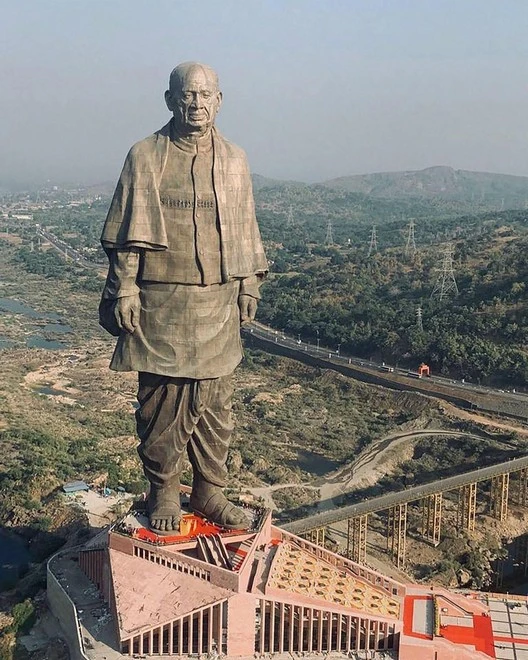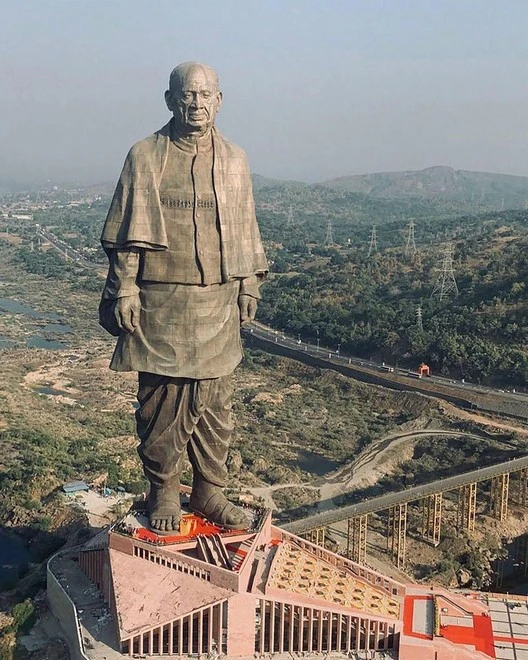Generated by Contentify AI

Introduction
The Statue of Unity, standing tall as a symbol of unity and strength in India, holds within its construction a tapestry of lesser-known tales that enrich its significance. From the intricate engineering feats that were overcome during its creation to the historical and cultural inspirations that shaped its design, the statue’s story goes beyond its physical presence. Delving into these untold narratives unveils a deeper appreciation for this monumental structure and the values it represents.
-introduction
The journey of the Statue of Unity begins with the meticulous planning and execution of its construction. The statue’s core is a blend of reinforced concrete and steel framework, ensuring its resilience against natural elements. The outer facade, crafted with bronze cladding, required skilled artisans to meticulously assemble the pieces like a giant puzzle. Behind this facade lie the stories of these craftsmen who poured their expertise and dedication into every detail, creating a masterpiece that stands as a tribute to unity and national pride.
Beyond its architectural marvels, the Statue of Unity is steeped in historical and cultural significance. The statue’s design draws inspiration from Sardar Vallabhbhai Patel, a prominent figure in India’s struggle for independence. It stands as a tribute to his unwavering leadership and vision of a united India. The location of the statue, overlooking the Sardar Sarovar Dam on the Narmada River, further symbolizes Patel’s role in unifying the diverse states of India into one nation.
Unraveling the unknown stories behind the Statue of Unity reveals a tapestry of craftsmanship, history, and symbolism that enrich its significance. Each element of its construction and design reflects a deeper narrative that resonates with the values of unity, strength, and resilience. The statue stands not only as a towering monument but as a testament to the enduring spirit of a nation united in diversity.
-Design and Architecture of the Statue
The design and architecture of the Statue of Unity embody not just a physical structure but a testament to the unity and strength of a nation. The statue’s construction required a blend of engineering precision and artistic flair. Crafted from reinforced concrete and a steel framework, the statue’s core stands as a testament to resilience and durability. The meticulous assembly of the bronze cladding by skilled artisans not only showcases their expertise but also symbolizes the unity of diverse talents coming together for a common purpose.
Inspired by the vision of Sardar Vallabhbhai Patel, the design of the statue holds historical and cultural significance. Positioned overlooking the Sardar Sarovar Dam, it serves as a reminder of Patel’s role in unifying India’s states into a single nation. The architectural marvel of the Statue of Unity goes beyond its physical form, embodying the values of unity, diversity, and national pride.
Every element of the statue’s design tells a story of craftsmanship, history, and symbolism that adds layers of significance to this monumental structure. It stands not only as a tribute to a great leader but as a beacon of unity and strength for generations to come. The unknown stories behind the Statue of Unity unveil a narrative of resilience and unity that transcends its physical presence, leaving a lasting impact on all who encounter it.
-The Artist behind the Creation
The creation of the Statue of Unity, a symbol of unity and strength in India, is a tale woven with intricate details and hidden narratives. Behind its towering presence lies the artistry and vision of the sculptor who brought it to life. Ram V. Sutar, the acclaimed Indian sculptor behind the statue, meticulously crafted the design that pays homage to Sardar Vallabhbhai Patel, a key figure in India’s history. Sutar’s attention to detail and dedication to capturing Patel’s essence in bronze form is a testament to his skill and passion for storytelling through art. From the initial concept sketches to the final installation, Sutar’s journey in creating the Statue of Unity is a captivating story of artistic prowess and historical reverence. The unknown stories behind the Statue of Unity reveal the collaborative effort of talented individuals, like Ram V. Sutar, who breathed life into this iconic monument, transcending mere construction to embody a powerful symbol of unity and national pride.
-Historical Significance and Symbolism
Ram V. Sutar, the master sculptor behind the Statue of Unity, intricately wove stories within the bronze cladding of the monument, embodying the vision of unity and strength. His artistic journey unfolds in each chiseled detail, capturing the spirit of Sardar Vallabhbhai Patel and the essence of India’s history. From the initial concept sketches to the final installation, Sutar’s dedication to storytelling through art is evident in every curve and line of the statue. The untold narratives of collaboration and craftsmanship that shaped the creation of the Statue of Unity echo the resilience and unity it symbolizes, cementing its place as a monumental tribute to a united nation.
-Challenges Faced during Construction
During the construction of the Statue of Unity, numerous challenges were encountered, each adding a layer of complexity to the monument’s creation. The sheer scale of the statue presented logistical hurdles that needed to be carefully navigated. From sourcing materials to transporting them to the site, the project required meticulous planning and coordination. Additionally, the intricate design of the statue demanded a high level of precision and expertise from the craftsmen involved in its construction. These skilled artisans worked tirelessly to bring the vision of the statue to life, overcoming obstacles with determination and skill. The stories of these challenges faced during the construction of the Statue of Unity not only highlight the dedication and effort put into its creation but also underscore the significance of this iconic monument as a symbol of unity and strength.
-Visitor Experience at the Statue
-Visitor Experience at the Statue
Visitors to the Statue of Unity are greeted not only by its towering presence but also by the rich tapestry of history and culture that envelops the monument. As they approach the statue, the intricate craftsmanship of the bronze cladding and the sheer magnitude of its form leave a lasting impression. The design, inspired by the vision of Sardar Vallabhbhai Patel, offers visitors a glimpse into India’s struggle for independence and the unification of its diverse states. The location of the statue, overlooking the Sardar Sarovar Dam, adds a layer of symbolism, connecting visitors to the significance of water conservation and agricultural development in the region.
Guided tours and interactive exhibits enhance the visitor experience, providing insights into the construction process, the life of Sardar Vallabhbhai Patel, and the cultural heritage that the statue embodies. Visitors can also explore the museum at the base of the statue, which houses artifacts and exhibits detailing Patel’s contributions to India’s history. The viewing gallery at the top of the statue offers panoramic views of the surrounding landscape, inviting visitors to reflect on the unity and diversity of the nation.
The unknown stories behind the Statue of Unity come to life through the visitor experience, offering a multi-dimensional journey that celebrates the values of unity, strength, and resilience. Each visit to the statue unveils a new layer of history and culture, enriching the connection between visitors and this iconic symbol of national pride.
-Environmental Impact and Sustainability Measures
The environmental impact and sustainability measures surrounding the construction of the Statue of Unity are essential components of its untold narratives. Amidst the grandeur of this monumental structure lies a commitment to preserving the surrounding ecosystem. The strategic placement of the statue on Sadhu Bet Island aimed to minimize disruption to the local flora and fauna, showcasing a thoughtful approach to environmental conservation. Additionally, sustainable practices were implemented throughout the construction process, such as recycling waste materials and utilizing renewable energy sources wherever possible. These initiatives not only underscore the dedication to preserving the environment but also add a layer of depth to the statue’s story, highlighting a harmonious balance between human achievement and ecological stewardship. The unknown stories behind the Statue of Unity reveal a narrative of environmental consciousness and sustainability, weaving together the threads of heritage, unity, and environmental responsibility into the fabric of this iconic monument.
-Local Community and Economic Benefits
The local community surrounding the Statue of Unity has experienced a ripple effect of economic benefits since the monument’s inception. The influx of tourists drawn to the statue has not only boosted the region’s hospitality and tourism industries but has also created employment opportunities for local residents. Small businesses, from souvenir shops to eateries, have flourished as a result of the increased foot traffic brought in by the statue. Additionally, infrastructure development in the area, including improved transportation networks and accommodations, has further stimulated economic growth in the region. The Statue of Unity stands not only as a symbol of national pride but also as a catalyst for economic prosperity within the local community.
-Controversies and Criticisms
-Controversies and Criticisms
As with any monument of such grand scale and significance, the Statue of Unity has not been immune to controversies and criticisms. One of the primary criticisms revolves around the displacement of local tribal communities due to the construction of the statue and the infrastructure development in the region. The project faced backlash for potentially disrupting the lives and livelihoods of these communities, raising concerns about social justice and environmental impact. Additionally, some critics questioned the allocation of resources towards building such a monumental structure, arguing that the funds could have been utilized for more pressing social and developmental needs. The statue’s portrayal of Sardar Vallabhbhai Patel has also been a point of controversy, with debates arising over the interpretation of his legacy and the political motivations behind the statue’s construction. These controversies and criticisms surrounding the Statue of Unity offer a nuanced perspective on its creation and shed light on the complex narratives that intertwine with its towering presence.
-Conclusion
The controversies and criticisms surrounding the Statue of Unity have brought to light a complex tapestry of perspectives that add layers of depth to its narrative. One of the key points of contention revolves around the displacement of local tribal communities during the construction and subsequent development in the region. This issue has raised questions about social justice and the potential environmental impact of such large-scale projects. Additionally, there have been debates regarding the allocation of resources for the statue, with critics arguing that the funds could have been better utilized for addressing pressing social and developmental needs. The portrayal of Sardar Vallabhbhai Patel and the political motivations behind the statue’s construction have also been subjects of scrutiny and debate. These controversies and criticisms provide a nuanced perspective on the creation of the statue, highlighting the multifaceted nature of its story and the various unknown narratives that underlie its towering presence.
Conclusion
As with any monumental structure, the Statue of Unity has its share of controversies and criticisms that have shaped its narrative. One of the main points of contention revolves around the displacement of local tribal communities during the construction phase, underscoring concerns about social justice and environmental impact. Additionally, debates have arisen regarding the allocation of resources for the statue, with some questioning whether the funds could have been directed towards more pressing social and developmental needs. The portrayal of Sardar Vallabhbhai Patel and the political nuances behind the statue’s creation have also sparked discussions and differing perspectives. These controversies and criticisms surrounding the Statue of Unity offer a nuanced view of its creation, revealing the intricate and multifaceted stories that lie beneath its grand facade.



